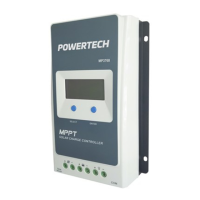12
INSTALLATION:
ATTENTION
• Be very careful when installing the batteries. Please wear eye protection
when installing the open-type lead-acid battery and rinse with clean
water in time for battery acid contact.
• Keep the battery away from any metal objects, which may cause a
battery short circuit.
• Acid gas may be generated when the battery is charged. Ensure that the
surrounding environment is well ventilated.
• Avoid direct sunlight and rain infiltration when installing it outdoor.
• Loose power connections and corroded wires may result in high heat
that can melt wire insulation, burn surrounding materials, or even
cause a fire. Ensure tight connections and secure cables with clamps to
prevent them from swaying while moving the inverter.
• Only charge the lead-acid and lithium-ion batteries within the control
range of this controller.
• The battery connector may be wired to another battery or a bank of
batteries. The following instructions refer to a singular battery. Still, it is
implied that the battery connection can be made to either one battery
or a group of batteries in a battery bank.
• Select the system cables according to 5A/mm2 or less current density.
REQUIREMENTS FOR THE PV ARRAY
(1) Serial connection (string) of PV modules
As the core component of the solar system, the controller needs to suit
various PV modules and maximize solar energy conversion into electricity.
According to the open-circuit voltage (VOC) and the maximum power point
voltage (VMPP) of the MPPT controller, the serial connection of PV modules
suitable for dierent controllers can be calculated. The below table is for
reference only.
System
voltage
36cell
Voc < 23V
48cell
Voc < 31V
54cell
Voc < 34V
60cell
Voc < 38V
Max. Best Max. Best Max. Best Max. Best
12V 4 2 2 1 2 1 2 1
24V 4 3 2 2 2 2 2 2
System
voltage
72cell
Voc < 46V
96cell
Voc < 62V
Thin-Film module
Voc > 80V
Max. Best Max. Best
12V 2 1 1 1 1
24V 2 1 1 1 1

